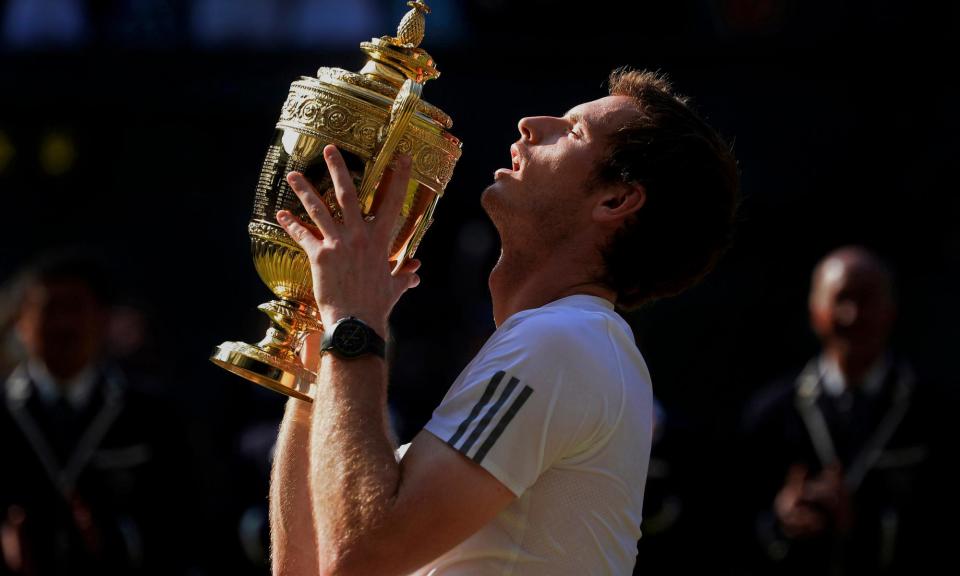Andy Murray exits as one of the greatest with a legacy as a true fighter

Nineteen years after taking his first steps in the Wimbledon main draw as a hopeful, precocious teenager already surrounded by suffocating hype, Andy Murray’s unprecedented grand slam singles career has come to an end. On Tuesday, he announced his withdrawal from the men’s singles draw at his final Wimbledon due to a persistent back injury.
Murray had been scheduled to face Tomas Machac of the Czech Republic on Tuesday evening, the latest possible slot on Centre Court, but after undergoing back surgery only 10 days earlier, he was simply unable to recover enough to be competitive across the best of five sets, despite making massive strides.
Related: Fans camp out for tickets to see Andy Murray ‘one last time’ at Wimbledon
He closes off his singles career at the major tournaments as one of the finest male tennis players the sport has ever seen. Murray won three grand slam titles, his first coming at the US Open in 2012 before winning twice at Wimbledon in 2013 and 2016. While his 2013 triumph marked him as Great Britain’s first male Wimbledon singles champion in 77 years, the second one helped him finally rise to No 1 in the world.
For most of Murray’s peak years, contending for the biggest titles meant desperately trying to hold his ground against Novak Djokovic, Rafael Nadal and Roger Federer, who split such a large proportion of major titles between them. Winning a grand slam usually meant beating two of the greatest players of all time in one tournament and absorbing many defeats in the process.
In 2005, Murray arrived at Wimbledon with a growing profile and he left as a player widely tipped for greatness. After easily reaching the third round, he led David Nalbandian by two sets before his body crumbled and he lost in five sets. Even at 18 years old, Murray was blessed with a varied, improvisational game, a vast arsenal of shots and an acute understanding of how to use them to inflict maximum discomfort on his opponent. But he was naturally slender and weak compared to the grown men on the ATP tour across the best-of-five-set format of grand slam tournaments.
How Murray addressed that gap has defined his career. The Scot transformed that weakness into one of his biggest strengths, working through countless training blocks in the suffocating humidity of Miami, methodically turning himself into a player who could use his own stamina and strength to outlast all challengers.
Three years later, he produced one of the decisive moments in his grand slam career as he recovered from two sets down against Richard Gasquet in the dying light on Centre Court in the fourth round of Wimbledon 2008. As he took victory, Murray flexed his right biceps in celebration of a triumph that underlined his efforts.
Related: Refusing to throw in the towel is a fitting finale in its own right for Murray at Wimbledon
But even as he established himself as a towering figure in professional tennis, a perennial top-four player who swept up Masters 1000 titles and established a level of consistency on a similar level to the three all-time greats ahead of him, in the biggest tournaments of all, the grand slams, Federer, Djokovic and Nadal each had the better of him.
Between Murray’s first grand slam final at the 2008 US Open and his maiden victory four years later at the same venue, Murray lost his first four grand slam finals, winning only one set in three defeats to Federer and one to Djokovic. As was the case throughout Murray’s career, he had to endure many devastating losses, but his resilience and determination allowed him to learn from them and become a better player.
What he lacked in natural ability, Murray made up for by improving every aspect of his game, eking as much as possible out of his physicality, his tactical nous and problem-solving talent. Finally, with his hiring of Ivan Lendl in 2012. Murray understood that in order to take down the greatest players, he had to put his perfectionism to the side and to accept the errors that naturally come with taking risks.
The paradox of Murray is that he is a tinkerer and a strategist who would leave no stone unturned in his preparation before matches. But so often, when things went wrong and he found himself down in a set and a match, his success was driven by his most important strength: his ability to fight, compete and scrap until the bitter end.
In the end, the considerable efforts it took for Murray to become a champion are reflected in the numerous physical issues he has suffered later in his career, including the hip problems that led to the insertion of a metal hip in his body. After all that he has put into himself and his sport, Murray was deserving of one more opportunity to take to Centre Court and battle until the end. Still, in his attempts to make it back 10 days after back surgery, Murray has offered a final glimpse into the commitment and love that he has for the sport, which has underscored his career for the past two decades.
